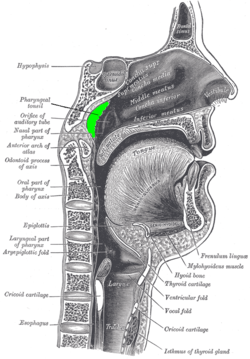Adenoids
| Pharyngeal tonsil | |
|---|---|

Location of the adenoid
|
|
| Details | |
| System | Immune system (Lymphatic system) |
| Identifiers | |
| Latin | tonsilla pharyngea |
| MeSH | A10.549.100 |
| Dorlands /Elsevier |
t_13/12812454 |
| TA | A05.3.01.006 |
| FMA | 54970 |
|
Anatomical terminology
[]
|
|
The adenoid, also known as a pharyngeal tonsil or nasopharyngeal tonsil, is the superior-most of the tonsils. It is a mass of lymphatic tissue situated posterior to the nasal cavity, in the roof of the nasopharynx, where the nose blends into the throat. Normally, in children, it forms a soft mound in the roof and posterior wall of the nasopharynx, just above and behind the uvula.
The adenoid, unlike the palatine tonsils, has pseudostratified epithelium. The adenoid is often removed along with the palatine tonsils.
Adenoids develop from a subepithelial infiltration of lymphocytes after the 16th week of embryonic life. They are part of the so-called Waldeyer ring of lymphoid tissue which includes the palatine tonsils and the lingual tonsils.
After birth, enlargement begins and continues until aged 5 to 7 years. Symptomatic enlargement between 18 and 24 months of age is not uncommon, meaning that snoring, nasal airway obstruction and obstructed breathing may occur during sleep. However, this may be reasonably expected to decline when children reach school age, and progressive shrinkage may be expected thereafter.
The establishment of the upper respiratory tract is initiated at birth. Species of bacteria such as lactobacilli, anaerobic streptococci, actinomycosis, Fusobacterium species, and Nocardia are normally present by 6 months of age. Normal flora found in the adenoid consists of alpha-hemolytic streptococci and enterococci, Corynebacterium species, coagulase-negative staphylococci, Neisseria species, Haemophilus species, Micrococcus species, and Stomatococcus species.
...
Wikipedia
